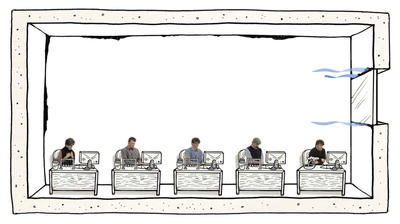You are here
Water also moves through building envelope assemblies—in both liquid and vapor states. Unwanted infiltration can be a major cause of this. The focus here is upon water vapor movement. Water vapor will often need to be handled by a climate control system through the use of energy (termed latent heat).
 |
Infiltration causes surprisingly large heat loss because unwanted moisture (latent heat) often must be removed from the air. |
Infiltration causes surprisingly large heat loss because unwanted moisture (latent heat) often must be removed from the air.
Infiltration
Infiltration is when air enters or leaves the building as a result of unintentional gaps in the building envelope, and/or between the insulation and the framing of a building. This allows outside air to bypass the insulation and convectively cool or heat interior spaces. Infiltration can be an enormous problem--the US Department of Energy estimates that up to 40% of residential heat loss is due to infiltration. One reason it impacts energy use so much is that moisture within humid air causes occupant discomfort and removing it is very energy intensive (latent heat).
Buildings in cold climates are more sensitive to infiltration of outside air. Buildings in moderate climates and/or with high internal loads are less sensitive to infiltration, and can even benefit from reduced cooling energy use due to the natural ventilation qualities of infiltration. Buildings in very hot climates are only moderately sensitive to infiltration due to the lower temperature differential between outside and inside.
Commercial building air handling systems are generally designed for positive pressure, meaning infiltration is reduced when the system is operating.
Moisture Control
Dehumidification requires the removal of the latent heat and is an important function of HVAC systems (See Humidity Control).
The information below on latent heat flows and envelope design are excerpted from Mechanical and Electrical Equipment for Buildings By Walter T. Grondzik, Alison G. Kwok, Benjamin Stein, John S. Reynolds. Page 197.
In the summer, moisture will typically flow into an air-conditioned building, increasing humidity and requiring dehumidification. In the winter, it is not unusual to add water vapor to the air in a building to keep the relative humidity from dropping too low. This is often accomplished by evaporating water by adding the latent heat of vaporization. In some building types and climates, dealing with latent heat may be as big a problem as dealing with sensible heat.
Moisture Control
A difference in vapor pressure is the driving force behind moisture flow through components of an intact building envelope assembly, while gaps in the envelope can provide a route for airflow that carries water vapor. Vapor pressure difference is to latent heat flow as temperature difference is to sensible heat flow. The permeance of the materials of construction is the latent equivalent of sensible conductance. The less permeable a material is, the greater the resistance to water vapor flow. Materials with low permeance are termed vapor retarders, and are incorporated in envelope constructions as a means of reducing the flow of water vapor and subsequently the risk of condensation of the vapor within the envelope assembly. From an architectural design perspective, reducing water vapor flow is accomplished using very thin materials (membranes) that must be carefully located to ensure that they work as intended. Although placement within an envelope assembly is critical, vapor retarders take up virtually no space—in drastic contrast to the thickness requirements of sensible heat retarders (insulations). The specific location of a vapor retarder within a wall, roof, or floor cross section will vary with climate and construction types. The fundamental principle, however, is for the retarder to stop the flow of water vapor before the vapor can come in contact with its dew point temperature within the assembly.
Cold Climate Moisture Control
Most common building materials, including gypsum board, concrete, brick, wood, and glass fiber insulation, are easily permeated by moisture. Most surface/finish materials are also permeable. In cold climates, the winter outside air contains relatively little moisture, even though the RH may be high. By contrast, inside air contains much more moisture per unit of volume, despite its probably lower RH. The resulting differential vapor pressure drives the flow of water vapor from high to low vapor pressure.
Hot, Humid Climate Moisture Control
In hot, humid conditions, cool inside surfaces are often encountered—for example, a radiant cooling panel containing chilled water, a water pipe, or a supply air diffuser. Hot and humid air contacts such a surface and condensation can occur. The moisture vapor in the air condenses to form visible droplets of water on the cool surface. The result can be mildly annoying if droplets of condensation fall on occupants, or serious if water stains occur and, eventually, mold grows on damp surfaces.
